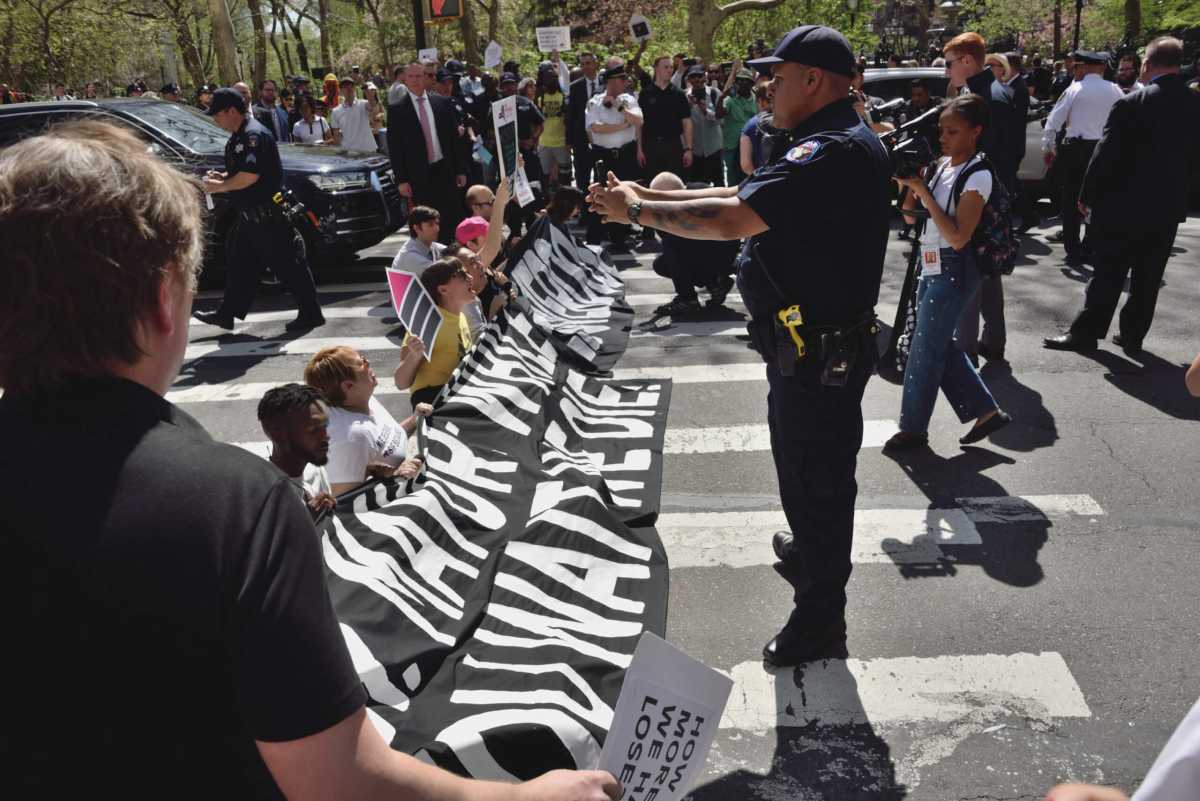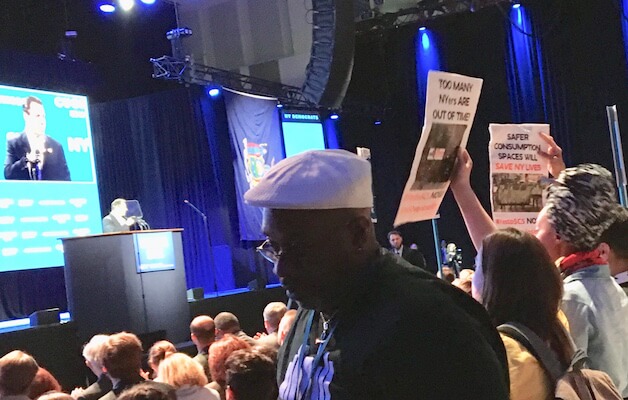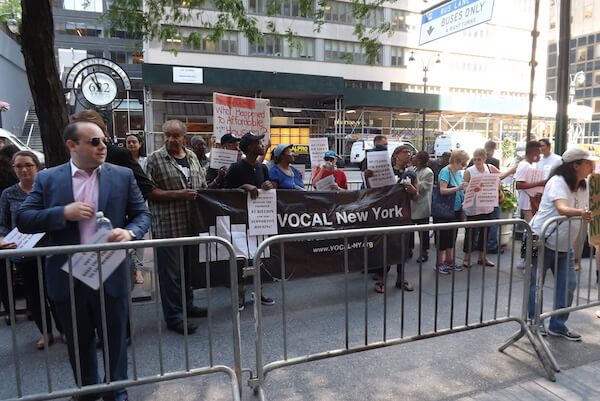Mayor Bill de Blasio. | DONNA ACETO
A multi-year push in New York City to offer drug users a safe place for consuming their drugs seems destined for success after Mayor Bill de Blasio announced his support for “overdose prevention centers.”
Public health advocates voiced enthusiasm as the news spread on May 3 that the administration had reached out to Dr. Howard Zucker, the state health commissioner, for a go-ahead to open four Safer Consumption Spaces in the Bronx, Manhattan, and Brooklyn.
Brooklyn City Councilmember Stephen Levin, the chair of the General Welfare Committee who was arrested the day before in a sit-in on Lower Broadway opposite City Hall to push de Blasio to act, tweeted: “Where others look down upon our most vulnerable we will show love and a path towards recovery.”
Thanking the mayor, Levin added, “This will save lives.”
After months of protests, mayor rolls out plan with significant political, health institution support
De Blasio’s action came in the wake of a city health department study of this approach toward curbing drug overdoses funded by the City Council in 2016 and completed this past December.
The mayor set conditions that likely will easily be satisfied. He sought support from the city’s district attorneys, and Manhattan DA Cyrus Vance, Jr., and Brooklyn DA Eric Gonzalez immediately signaled their endorsements via Twitter.
“In the midst of an overdose crisis, we cannot sit by and let ppl die when there are proven interventions that can save live,” Gonzalez wrote, while Vance said, “We are proud to support the Mayor’s proposal to establish Overdose Prevention Centers. Thanks for your leadership.”
Darcel Clark, the Bronx DA, has held meetings on the intervention but remains hesitant unlike her peers, saying only that she has an “open mind.” Clark faces the voters for reelection in 2019, while Vance and Gonzalez won four year terms this past November.
In a written statement, Corey Johnson, the City Council speaker who initially pushed the proposal in 2016 when he chaired the Health Committee and got $100,00 put into the budget to have the health department carry out the study, said, “We thank Mayor de Blasio for taking this brave, important, and necessary step.”
Councilmember Stephen Levin taken into custody during the May 2 sit-in. | DONNA ACETO
Johnson, who is gay and HIV-positive, often expresses sympathy for those who have died from drug overdoses, mentioning his own history with alcohol and drug use, from which he has been in recovery for years.
“Too many people have died from opioids and heroin,” he said. “These sites will save lives and connect addicts with treatment options and trained professionals that could lead them to recovery. This is an issue that has deep personal significance to me.”
The US Justice Department has issued quasi-official opinions that Safer Consumption Spaces are illegal, but the mayor, by establishing the sites as temporary research programs, believes Zucker has the legal authority to approve their operation.
In the de Blasio administration’s letter to Zucker, Dr. Herminia Palacio, the deputy mayor for health and human services, asked “for immediate steps under Public Health Law to license a pilot research study.” The license would “include the possession of controlled substances.” She cited as precedent the pilot research that authorized needle exchanges whose distribution of sterile syringes brought dramatic reductions in new HIV infections among injection drug users.
The plan has the strong support of Chelsea State Assemblymember Richard Gottfried, who chairs the Health Committee.
“The Mayor’s announcement is an important step and a testament to the hard work of public health advocates on this issue,” Gottfried said in an email to Gay City News, adding, “Supervised injection facilities are an effective harm reduction strategy and a place where people can be connected with appropriate health care and social services.”
A letter to de Blasio from Charles King, president of Housing Works, the AIDS services group, demonstrates the quiet persuasion — that was coupled with loud protests from advocates, as well — that got city leaders behind this project. King was writing in his capacity as chair of Research for a Safer New York, Inc., a consortium of syringe exchanges that have found themselves treating overdoses and assisting clients who have injected in their facilities’ bathrooms.
This consortium will be the contractor managing the overdose prevention centers, with Dr. Holly Hagan, an epidemiologist at NYU, overseeing the research effort. NYU has agreed to have its Institutional Review Board evaluate the study design.
The mayor acted after the four city councilmembers where the initial overdose prevention centers will be sited had already endorsed the idea. Johnson and Levin, in particular, had voiced considerable frustration with de Blasio's slow pace of acting on the issue.
In Upper Manhattan, the Washington Heights Corner Project has agreed to sign a contract with the consortium. Liz Evans, a founder of the Vancouver Needle Exchange in Canada that opened in 2003, is on staff there. Mark Levine, the chair of the City Council Health Committee and a supporter of SCS, represents the district that includes the Corner Project.
St. Ann’s Corner of Harm Reduction, where this writer was formerly chair of the board, participated in the Bronx Opioid Community Summit on April 21. At the meeting, Councilmember Rafael Salamanca, who represents the district where St. Ann’s is located, gave a moving talk about growing up in the Bronx where drug use was common and visible. He emphasized the opportunity to bring change to people’s lives through love and compassion. His remarks, which included his endorsement of Safer Consumption Spaces, drew a standing ovation.
The other participating needle exchanges are run by Housing Works, in Midtown West, in Johnson’s district, and VOCAL-NY, which has space within walking distance of the Atlantic Avenue-Barclay Center subway complex. Levin is the councilmember for that district.
In testimony before the Council’s Budget Committee in February, Dr. Mary Bassett, the city health commissioner, said the scientific evidence that these facilities stop fatal overdoses is “clear.”
Demonstrators sat in on Lower Broadway near City Hall after a May 2 speakout on Safer Consumption Spaces called by VOCAL-NY, Housing Works, and the Drug Policy Alliance demanding that Mayor Bill de Blasio release the city report on this approach to curbing overdose deaths. The mayor acted the next day. | DONNA ACETO
Drug users, especially those taking opioids, frequently overdose, but in Safer Consumption Spaces they receive assistance in breathing with doses of naloxone, a public health wonder drug. A plastic nozzle is used to squirt the medication into a user’s nostril and the opioid is inhibited and normal breathing is restored. In Safer Consumption Spaces worldwide — located in more than 100 cities — there have been no reported fatalities.
In upstate Ithaca, Mayor Svante Myrick and the City Council have already approved a Safer Consumption Space. Philadelphia and San Francisco are also moving forward on this approach, though no such facility is yet in operation in the US.
According to Politico, the number of overdose deaths in New York City hit a record 1,441 in 2017, with 80 percent of them from opioids.
Even as Housing Works’ King lauded de Blasio, he expressed frustration about how long it took to get to this day.
“Housing Works is thrilled that Mayor de Blasio has stepped up to do the right thing, and given the skyrocketing rates of overdose in New York City, we only wish this administration’s support for an intervention that we have long known to save lives had come sooner,” he said in a written statement, adding, “One thing we have learned from years of fighting the AIDS epidemic is that harm reduction works.”






































